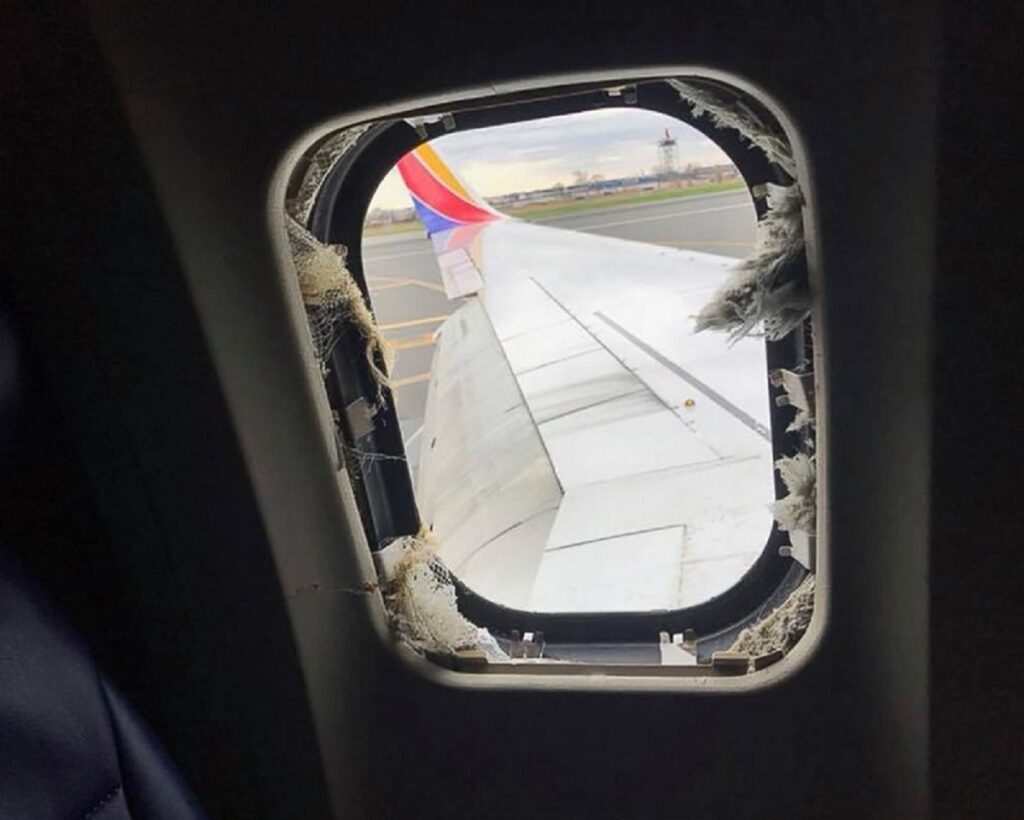
Airplane windows are relatively strong. The main thing to know is that aircraft cabin windows are not made of glass but with stretched acrylic.
You won’t be able to break an airplane’s window with your fist as it has 3 layers consisting of the outer, middle and inner panes.
The outer pane is made of stretched acrylic plastic to withstand the pressurization load. If it cracks, the middle pane will take the load as this pane act as a fail-safe layer.
This material is lightweight and you can see clearly though it. The middle layer usually has a tiny hole in it to get rid of condensation.
The inner pane basically safeguards the load from the passengers during flight.
When both the outer and middle panes break, then all the pressurization in the airplane would escape leading to decompression in the passenger cabin.
A plane is pressurized for passengers’ comfort as it climbs to a higher altitude. On the ground, the surface pressure is 14.7 psi (pounds per square inch) and by 35,000 feet, it would drop to less than 4 psi creating a high differential pressure during the cruise.
Just like a balloon, when the window breaks, air will rush out. Anything loose inside the plane like phones, handbags, magazines, including humans, would be sucked out.
A rapid decompression leading to depressurization would come with a loud noise accompanied with cabin air being cooled and condensed into fog due to sudden reduction of air pressure and temperature.
If a passenger window blows out, there’ll be a bang, a whoosh for a couple seconds as the air pressure escapes (it’s just a bigger version of cracking open a bottle of soda), fog will form in the cabin, and it’ll get quite chilly from the sudden pressure drop. Your eardrums will feel like they also want to blow out for a second, they might hurt, and you may notice the pressure differential in your sinuses until that air escapes. You might feel abdominal bloating if you’re paying attention in all the commotion.
Whoever was right at the window, if their frame is small enough to be forced through the hole, might disappear out it (mostly, if their plevis will fit through). Or if they’re big enough, they might just form a plug in the window frame and help things out, (although it’ll probably kill them if their head made it outside).
You don’t want to be too close to the window, but otherwise you’ll be fine if you get the drop down mask on in time. If the plane is in the upper flight levels, you’ll have maybe 15 seconds before you pass out, after which someone else needs to put it on for you, or you could develop brain damage or even die.
Just sitting stationary, you won’t “feel’ the thin air just breathing it and start gasping for breath unless you’re exerting yourself (a surprising discovery for me when I went on a high altitude indoctrination course with a chamber ride long ago). The crew will immediately dive the plane to get to thicker air, so you’ll be at a safer altitude pretty quickly, within a minute or two.
The passenger windows are normally 1/4 inch thick acrylic plastic, and based on the tensile strength of acrylic (about 8000 psi IIRC), the strength of the window is more or less the same as the surrounding, much thinner, aluminum skin, so it takes quite a lot to make one blow out, which is why the event is so rare.





